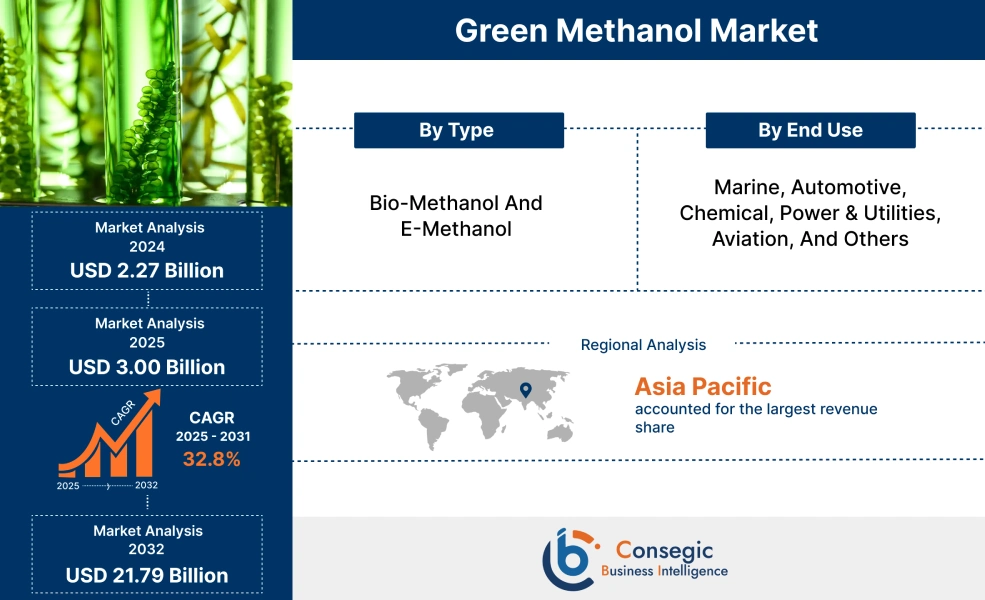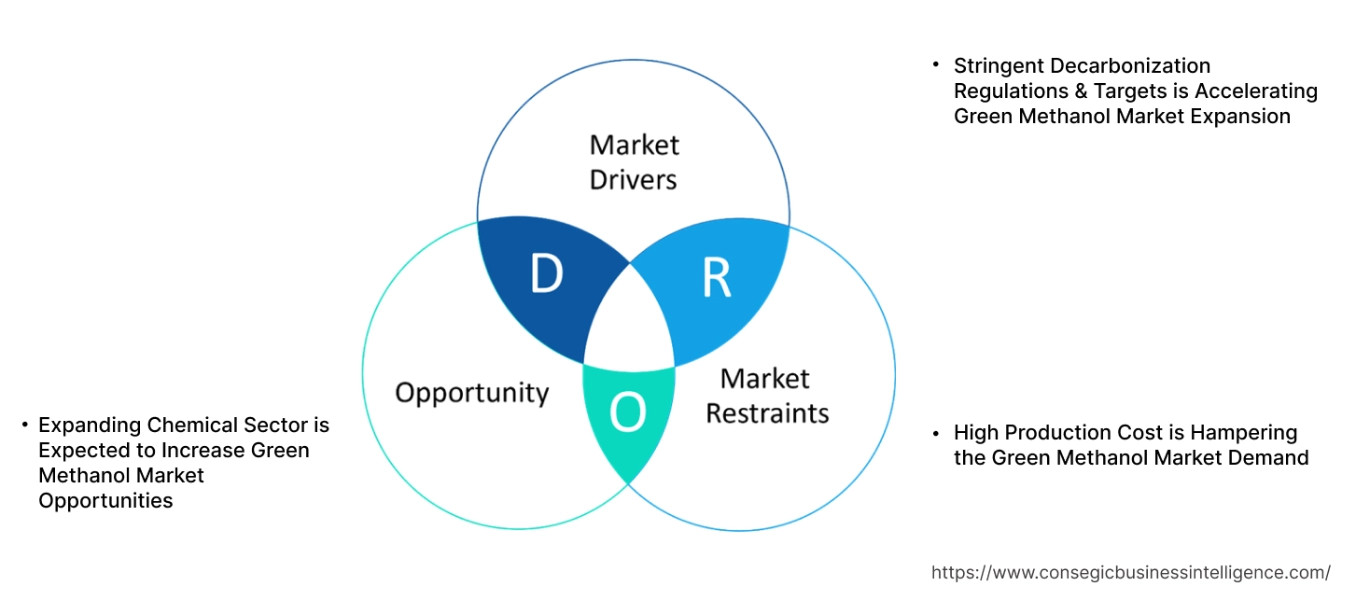Green Methanol Market Size:
Green Methanol Market size is growing with a CAGR of 32.8% during the forecast period (2025-2032), and the market is projected to be valued at USD 21.79 Billion by 2032 from USD 2.27 Billion in 2024. Additionally, the market value for the 2025 attributes to USD 3.00 Billion.
Green Methanol Market Scope & Overview:
Green methanol, also known as renewable methanol, is a sustainable alternative to conventional methanol. Traditionally, the manufacturing was fossil-fuel based. However, this sustainable alternative is produced with significantly reduced greenhouse gas emissions. It is produced from a variety of feedstocks. This includes biomass, green hydrogen, and captured carbon dioxide among others. There are two main types of this methanol, namely bio-methanol and e-methanol. Its main advantage is that it has a lower carbon footprint, making it useful in multiple industries such as automotive, marine, and chemical among others.
Green Methanol Market Dynamics - (DRO) :
Key Drivers:
Stringent Decarbonization Regulations & Targets is Accelerating Green Methanol Market Expansion.
Green methanol is a promising alternative to fossil fuels, as it is liquid in nature, which makes it easier to handle and store when compared to gaseous fuels such as hydrogen. It also offers up to 95% CO2 reduction compared to conventional methanol. There is rising global temperatures and extreme weather events. This has increased awareness in governments to combat climate change and limit global warming. For this, they are implementing strict decarbonization regulations. Regulatory bodies are introducing environmental policies. The policies are aimed at achieving net-zero greenhouse gas emissions. These regulations are being introduced particularly for sectors such as automotive and marine, to transition away from fossil fuels.
For instance,
- In 2023, the European Parliament introduced a new law requiring a 55% reduction in emissions for cars and a 50% reduction for vans by 2035, thus positively impacting green methanol market trends.
Overall, stringent decarbonization regulations and targets are significantly boosting the green methanol market expansion.
Key Restraints:
High Production Cost is Hampering the Green Methanol Market Demand.
Conventional methanol production has multiple benefits such as established infrastructure, low feedstock costs, and proven methods from long years. However, the production of renewable methanol is more complex and expensive. For instance, renewable methanol is produced through green hydrogen, and producing green hydrogen via method electrolysis involves substantial amounts of renewable electricity. Moreover, the capital expenditure (CAPEX) for electrolyzers is also relatively high. This increases the burden of cost. Additionally, for production, sourcing and processing sustainable biomass such as agricultural waste and forestry residues is costly, and it because of the collection, transportation, and pre-treatment requirements. Furthermore, in the production of e-methanol, the associated cost with capturing CO2 is also high. It especially comes from direct air capture. Hence, the high production cost is hampering the green methanol market demand.
Future Opportunities :
Expanding Chemical Sector is Expected to Increase Green Methanol Market Opportunities.
Renewable methanol is a vital sustainable feedstock for the chemical industry. Primarily, it serves as a key building block for formaldehyde, which is a critical component in resins developed for construction, adhesives, and textiles. Moreover, it is also helpful in producing acetic acid, which is a crucial component in solvents, polymers, and pharmaceuticals. Additionally, it is a raw material for dimethyl ether (DME), which is used as an aerosol propellant. Furthermore, they play a key role in other chemicals production such as olefins and methyl tert-butyl ether among others. Increasing demand for chemicals from various end-use industries such as consumer goods and electronics has led to sector growth, hence positively impacting green methanol market trends.
For instance,
- According to IBEF, the Indian chemical industry is expected to grow at a CAGR of 12% from 2023 to 2027.
Overall, expanding chemical sector is expected to increase the green methanol market opportunities.
Green Methanol Market Segmental Analysis :
By Type:
Based on type, the market is categorized into bio-methanol and e-methanol.
Trends in Type:
- There is a growing trend of using bio-methanol in multiple industries such as automotive. It is due to the rapid increase in large-scale production.
- The shipping sector targeting e-methanol, drawn by its scalability and high purity, is also a rising trend.
The bio-methanol segment accounted for the largest market share in 2024.
- Bio-methanol is produced from renewable organic materials, which are also known as biomass.
- These feedstocks include corn stover, sugarcane bagasse, forestry waste, municipal solid waste, biogas from landfills, and black liquor from the pulp and paper sector among others.
- It reduces waste generation, as it emits less greenhouse gas emissions, which is making it useful in industries such as marine and power generation among others.
- Key players are manufacturing bio-methanol using new feedstocks to promote environmental protection, hence driving the segment share.
- For instance, in 2024, Mitsubishi Gas Chemical become the first company in Japan to produce bio-methanol from digester gas, a byproduct of sewage treatment.
- Overall, as per the market analysis, the aforementioned factors are driving a segment in the green methanol market growth.
The e-methanol segment is expected to grow at the fastest CAGR over the forecast period.
- E-methanol, or electro-methanol, is produced using a power-to-liquid (PtL) process. It is created by combining captured carbon dioxide (CO2) with green hydrogen.
- Its key advantages include near-zero net carbon emissions on a life-cycle basis, as the CO2 used is recycled.
- Additionally, they are easily integrated into existing infrastructure, unlike gaseous hydrogen.
- The major sector utilizing e-methanol includes marine shipping, where it is serving as a clean fuel for decarbonizing vessels.
- It also having potential for use in automotive fuels and even as a precursor for sustainable aviation fuel (SAF). All these benefits are driving their increased usage.
- According to green methanol market analysis, the aforementioned factors will drive the segmental share for the upcoming years.
By End Use:
Based on end-use, the market is categorized into marine, automotive, chemical, power & utilities, aviation, and others.
Trends in the End-Use
- There is a growing trend of using green methanol in marines as a crucial alternative fuel to meet stringent IMO emission reduction targets.
- Increasing usage of green methanol in producing sustainable aviation fuels is also a rising trend.
The marine segment accounted for the largest market share of 37.13% in 2024.
- In the marine sector, renewable methanol is used as a cleaner-burning marine fuel for large cargo vessels, container ships, and tankers among others.
- The advantage of this methanol is that it significantly reduces sulfur oxide (SOx).
- It also reduces particulate matter emissions (by over 95%) and is helpful in cutting nitrogen oxides (NOx) by up to 80% compared to conventional fuels.
- The regulatory bodies are introducing new targets for emission reduction, pushing the marine sector to adopt low-carbon fuels such as renewable methanol, hence driving segment.
- For instance, in 2023, the International Maritime Organization adopted a revised greenhouse gas strategy including a target of 20% and 70% reductions in emissions by 2030 and 2040 respectively.
- Overall, as per the market analysis, the aforementioned factors are driving the segment in the green methanol industry.
The chemical segment is expected to grow at the fastest CAGR over the forecast period.
- Renewable methanol is produced using renewable energy sources. It is used as a feedstock for various chemicals productions to improve the cell’s performance.
- For example, it is used to make formaldehyde (for resins and adhesives), acetic acid (for plastics, textiles, and rubber), MTBE (a gasoline additive), and DME (a fuel alternative).
- Moreover, they utilize captured CO2, transforming a waste product into a valuable resource, hence closing the carbon loop.
- Additionally, its use aligns the chemical sector with global sustainability targets and meets the growing demand from regulators for environmentally responsible production. All these factors are driving its usage in the sector.
- Thus, according to market analysis, the aforementioned factors are driving segment in the green methanol market growth.
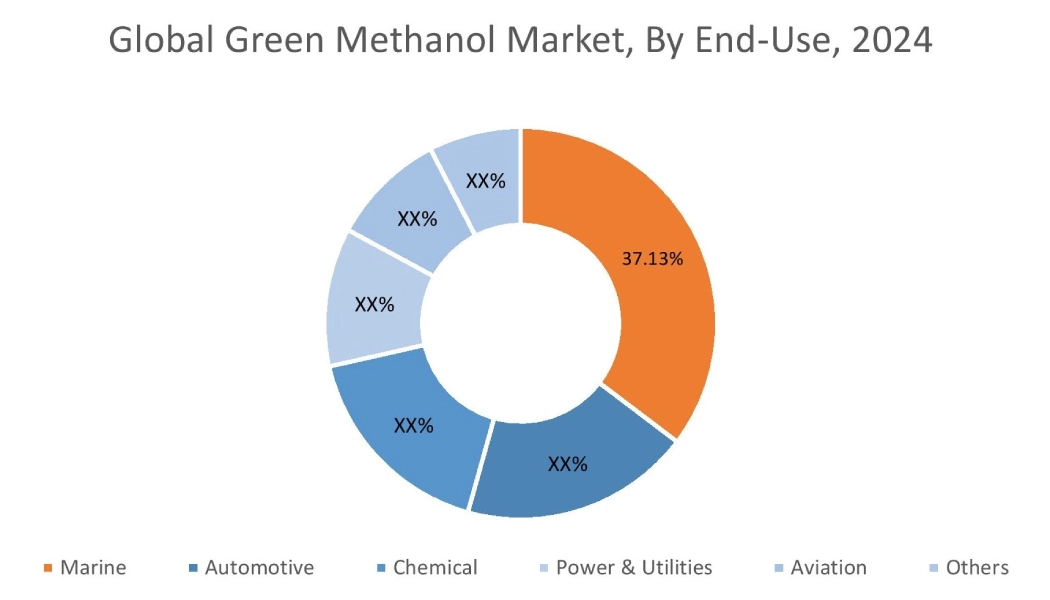
Regional Analysis:
The regional segment includes North America, Europe, Asia Pacific, the Middle East and Africa, and Latin America.
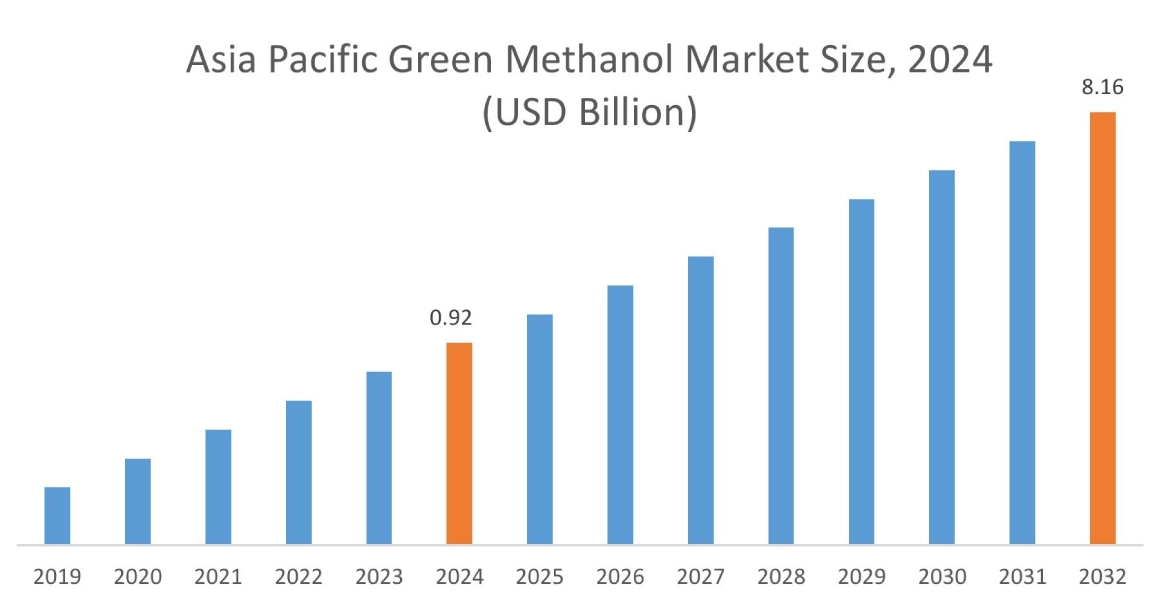
In 2024, Asia Pacific accounted for the highest green methanol market share at 40.78% and was valued at USD 0.92 Billion and is expected to reach USD 8.16 Billion in 2032. In Asia Pacific, the China accounted for the green methanol market share of 41.08% during the base year of 2024. There is increasing environmental regulations, such as those from the International Maritime Organization. This is accelerating the marine sector's push in countries of APAC for decarbonization in the region.
For instance,
- In 2025, India is set to announce new maritime regulations to align with the International Maritime Organization's (IMO) zero emission regulations, aiming to green the shipping sector and reduce carbon emissions.The new rules are based on the IMO's Revised GHG Strategy 2023 and require phased reduction in carbon dioxide emissions.
Renewable methanol is preferred as marine fuel. It offers a pathway to near-zero lifecycle greenhouse gas emissions. This aligns with stringent future targets. Overall, growing marine stringent regulations is driving the market in the region.
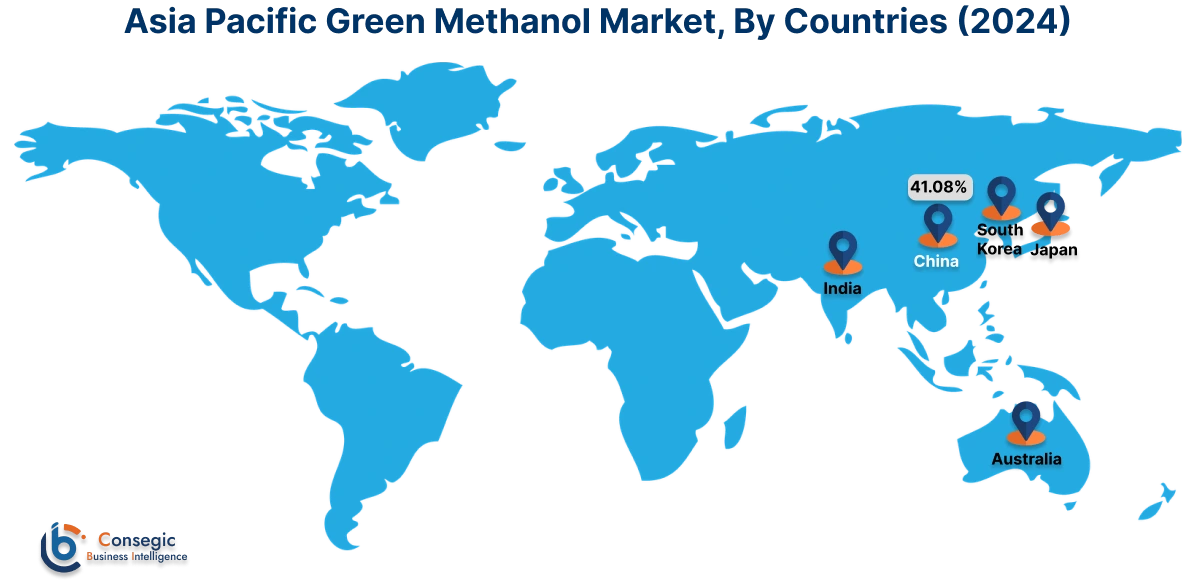
In Europe, the green methanol market is experiencing the fastest growth with a CAGR of 35.5% over the forecast period. In European countries, there is substantial investment in e-methanol production. Countries such as Germany, France, UK, and Italy are actively pursuing large-scale e-methanol projects. This surge in investment is driven by their vast industrial base and ambitious national decarbonization targets. The region also has significant renewable energy potential such as solar and wind among others. Companies are pouring capital into building facilities that combine captured CO2 with green hydrogen, generated from renewable electricity.
North America’s green methanol market analysis indicates that several key trends are contributing to its growth in the region. There is growing demand for sustainable fuels in its automotive sector. This trend is propelled by the ambitious Fit for 55 packages and the overarching goal of achieving carbon neutrality by 2050. This includes strict CO2 emission reduction targets for new vehicles. Renewable methanol is gaining traction as a complementary sustainable fuel. It is used as a direct fuel for specially designed vehicles. It offers a cleaner alternative that significantly reduces tailpipe emissions of harmful pollutants such as sulfur and nitrogen oxides.
The Middle East and Africa (MEA) market analysis indicates that there is significant growth in the chemical sector in the region. Historically, the MEA's chemical sector has leveraged abundant and low-cost fossil fuel feedstocks. However, now with increasing global pressure for sustainability, there is a growing pivot towards greener production. Renewable methanol is becoming crucial as they serve as building block for various chemicals. It is used to manufacture formaldehyde, olefins, and acetic acid among others. As MEA countries invest in advanced chemical complexes and look to reduce their carbon intensity, renewable methanol offers a viable pathway.
Latin America's region creates potential for the market. The aviation sector is growing in the region. Concurrently, there is a regional push for aviation decarbonization. The airlines and governments are seeking viable pathways to reduce emissions. Green methanol serves as a feedstock for the production of sustainable aviation fuels. Latin American countries, rich in biomass resources and renewable energy potential, are exploring domestic SAF production to meet future aviation fuel demand sustainably. This growing interest in decarbonizing air travel through SAF positions the aviation sector as a strong future growth catalyst for green methanol in the region.
Top Key Players and Market Share Insights:
The Green Methanol market is highly competitive with major players providing products to the national and international markets. Key players are adopting several strategies in research and development (R&D) and product innovation to hold a strong position in the global Green Methanol market. Key players in The Green Methanol industry include-
- Thyssenkrupp Uhde GmbH (Germany)
- Proman (Switzerland)
- Mitsubishi Gas Chemical (Japan)
- ABEL Energy (Australia)
- Methanex Corporation (Canada)
- OCI Global (Netherlands)
- Carbon Recycling International (Iceland)
- Sodra (Sweden)
Recent Industry Developments:
Product Launch:
- In 2024, Mitsubishi Gas Chemical begun commercial production of bio-methanol, utilizing digester gas from the Niigougawa Sewerage Plant in Niigata Prefecture, Japan. This bio-methanol, produced at MGC's Niigata Plant, is being certified by ISCC PLUS, ensuring the sustainability of its raw materials. The bio-methanol is expected to be used as chemical feedstock, fuel, and hydrogen feedstock, contributing to decarbonization efforts.
Green Methanol Market Report Insights :
| Report Attributes | Report Details |
| Study Timeline | 2019-2032 |
| Market Size in 2032 | USD 21.79 Billion |
| CAGR (2025-2032) | 32.8% |
| By Type |
|
| By End Use |
|
| By Region |
|
| Key Players |
|
| North America | U.S. Canada Mexico |
| Europe | U.K. Germany France Spain Italy Russia Benelux Rest of Europe |
| APAC | China South Korea Japan India Australia ASEAN Rest of Asia-Pacific |
| Middle East and Africa | GCC Turkey South Africa Rest of MEA |
| LATAM | Brazil Argentina Chile Rest of LATAM |
| Report Coverage |
|
Key Questions Answered in the Report
How big is the Green Methanol market? +
In 2024, the Green Methanol market is USD 2.27 Billion.
Which is the fastest-growing region in the Green Methanol market? +
Europe is the fastest-growing region in the Green Methanol market.
What specific segmentation details are covered in the Green Methanol market? +
Type and End-Use segmentation details are covered in the Green Methanol market.
Who are the major players in the Green Methanol market? +
Thyssenkrupp Uhde GmbH (Germany), Methanex Corporation (Canada), OCI Global (Netherlands), Carbon Recycling International (Iceland) and Sodra (Sweden) are some major players in the market.
